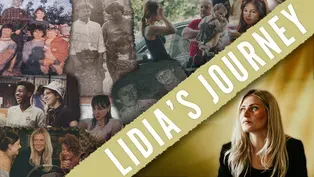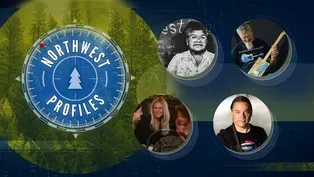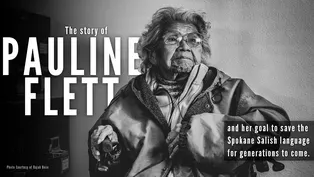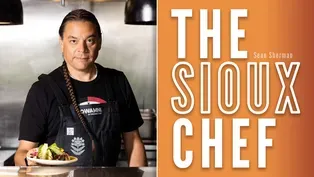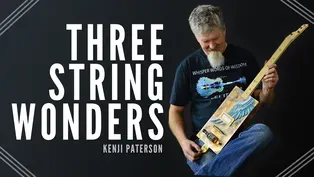Northwest Profiles
November 2022
Season 36 Episode 2 | 25m 31sVideo has Closed Captions
Pauline Flett; Indigenous Cuisine; Ukranian refugees in Spokane; 3-string box guitars.
NWP is celebrating Native American Heritage Month. Meet Pauline Flett, the woman who saved the Spokane Salish language for generations to come. Chef Sean Sherman, a Lakota Sioux introduces us to modern indigenous cuisine. A Ukrainian refuge herself, Lidia Pauline helps new refugees make a home in Spokane. And trek to Salmon Arm BC to see Kenji Paterson make unique 3-string box guitars.
Problems with Closed Captions? Closed Captioning Feedback
Problems with Closed Captions? Closed Captioning Feedback
Northwest Profiles is a local public television program presented by KSPS PBS
Funding for Northwest Profiles is provided by Idaho Central Credit Union, with additional funding from the Friends of KSPS.
Northwest Profiles
November 2022
Season 36 Episode 2 | 25m 31sVideo has Closed Captions
NWP is celebrating Native American Heritage Month. Meet Pauline Flett, the woman who saved the Spokane Salish language for generations to come. Chef Sean Sherman, a Lakota Sioux introduces us to modern indigenous cuisine. A Ukrainian refuge herself, Lidia Pauline helps new refugees make a home in Spokane. And trek to Salmon Arm BC to see Kenji Paterson make unique 3-string box guitars.
Problems with Closed Captions? Closed Captioning Feedback
How to Watch Northwest Profiles
Northwest Profiles is available to stream on pbs.org and the free PBS App, available on iPhone, Apple TV, Android TV, Android smartphones, Amazon Fire TV, Amazon Fire Tablet, Roku, Samsung Smart TV, and Vizio.
Providing Support for PBS.org
Learn Moreabout PBS online sponsorship♪ Hello and welcome to another edition of Northwest Profiles I'm your host Lynn Veltrie, and as always it great to have you with us especially on this occasion as we celebrate not only native American heritage month but also the start of the holiday season, a magical time of year that gives us a chance to reflect on what's truly important in our lives including spending quality time with our loved ones, extended family and friends like you.
We have on the way four stories sure to warm the heart.
Two of them help us celebrate native American heritage month while the other two celebrate the spirit of the holidays with an inspiring story of people helping those in need and a revealing look at a man whose craft and artistry leads to the gift of music.
So, with a full plate in hand I believe the time is now to get the festivities started.
We begin with a look at the life and work of Pauline Flett, who is credited with saving the Spokane Salish language by translating and transcribing hundreds of Salish stories... Pauline, worked at this passionately until her death in 2020.
Hear from those who knew her best about not only Pauline's dedication to preservation, but her impact and legacy throughout the Spokane region.
(music plays) (music plays) Pauline's work began over 50 years ago.
She began transcribing stories from old reel to reel that was were done in the late sixties, early seventies of tribal elders.
[Barry Carlson] Tape number 18.
Recording on August 11, 1969.
[Margaret Sherwood telling the s “How Coyote Got His Green Eyes ” [Marsha] And so she went through probably almost 200 tapes of reel to reels.
[Sulustu] And so she amassed this huge archive of Salish language materials.
[Margaret Sherwood telling the s “How Coyote Got His Green Eyes ” [Sulustu] That was all transcrib translated and neatly printed by [Margaret Sherwood telling the s “How Coyote Got His Green Eyes ” [music plays] One of our traditional teachings is that everybody has a purpose, everybody has a reason for living.
And I can see that she was the perfect person for the time in which she lived.
She never stopped learning.
She never stopped searching.
She never stopped trying to deepen her own understanding and her own knowledge of the language.
[Garrison] Somebody told me, is this true, that there are only about 50 speakers of the language today?
[Pauline] That is correct.
There is about 50 left.
[Garrison] Can it be saved?
[Pauline] Thats what Im trying to do now.
Trying to get it all written down.
For my kids and grandkids and great grandkids.
Everybody elses great grandkids.
[music plays] [Sulustu] And so she single handedly created this archive that we still use today.
[music plays] [Josh] Her last days, she was still writing in her notebooks, still going over the dictionary and making corrections.
And many times she didn't think her work mattered.
And I feel like she hung on as long as she did, because she was so afraid that if she left, no one would be continuing her work.
[Margo] You know, many tribes ha lost their language completely, but there are connectors.
People like Pauline who worked hard and were diligent about preserve being that langua [Young kids singing in Salish] And now there's a revitalization We have young people who are learning the language and are reading it and continue to speak it and teach it.
And so our language is alive.
[LeRae Wiley singing in Salish] [LeRae] I really feel like Pauline's spirit just the way she was, how kind and patient she was.
And she took that in her teaching.
And that really had an impact on me, that's how you treat people, that's how you treat learners.
And so all throughout my language journey, her presence, that idea of being being patient, treating everyone they're your grandchild, and tha kindness and love with the langu is something that I think she instilled in me.
[LeRae speaking in Salish] [Josh] Just marveled at how she could break it apart so easy and put it back together and des in simple terms that we could un Now, here I am, continuing her work the best I can.
The more I learn, the more I want to learn.
So it's kind of addicting.
And that's the way she looked at it, too, you know.
[Marsha] She said it was constant.
She would be up until three or 4 oclock in the morning, sometimes working on something.
if it hit her before she went to she'd have to write it down.
At one time I asked her, Why do you continue to do this?
And she goes, Well, if it was fo I would have quit a long time ag But it's for the kids.
So that's what I try to hold on to when the times get a little tough.
It's for the kids.
It's for the next generations.
[music plays] [music plays] For our next story we head to the kitchen to meet Sean Sherman, a member of the Lakota Sioux tribe who playfully calls himself the Sioux chef.
The accomplished chef is on a mission to revitalize native American cuisine and reclaim an important culinary culture.
I'm excited to be here, and this special dinner here at Masselow's, and working with one of the tribes.
I grew up on Pine Ridge Reservation, so I'm enrolled with the Oglala Lakota Sioux Tribe.
I was only 13 when I started working restaurants then all through high school, college and after college I moved to Minneapolis and then I worked my way up to a chef really quickly because I had a lot of years of experience already, and that was a few years into the chef career that I just realized The complete absence of indigenous foods out there And even though I grew up on a tribal community, I knew very little about my own, like Lakota ancestry when it came to food.
So it just really made me look deeper as to, you know, what happened to us as indigenous people, awhat were our food systems?
What we're ancestors gathering, hunting, foraging.
Was there knowledge of plants around us?
And just look at looking at all this through kind of a culinary lens and then just realizing why this is really important to get out there.
Looking at a lot of the health crisis is that which we share as indigenous peoples across the board, a lot of type two diabetes and obesity, a lot of poor nutritional access, a lot of us still stuck on commodity food programs and just trying to figure out a way to showcase modern indigenous foods that could really curb a lot of those health pieces.
I started my company, the Sioux Chef, in 2014, and I've been able to travel to almost every state, including a lot of Mexico and Canada and Alaska, and just really focus on what are North American indigenous foods out there.
Coming up with an idea for a restaurant to showcase what's possible with modern indigenous foods at the same time setting up a nonprofit to become a support center to help see more and more development around Indigenous foods on a larger scale.
So Owamni we opened in 2021 in July, and we've been sold out every single night since we opened.
And it's really just a proof of concept that we can have a nice restaurant that's got a lot of intention, that is focused on just the decolonization of what we're doing.
because we're at a nice restaurant, we get to make the plates look pretty and, we get to tell a story through these foods showcasing what's possible out there.
And it's really great to be able to have a restaurant where you can see a lot of indigenous peoples serving the food, cooking the food.
You see indigenous language on the menus hear indigenous music over the speakers.
And it's just a different feel that, you know, we should have these restaurants all over the nation, so we're just showing what's possible.
We just won this year's James Beard Award for Best New American Restaurant in the Entire Nation.
The nonprofit is NATIFS, which is that acronym North American Traditional Indigenous Food Systems.
And through NATIFS, we have a nonprofit kitchen in Minneapolis called Indigenous Food Lab.
We have two main focuses.
One is just creating access to indigenous education and one is creating access to indigenous foods.
So defining indigenous education is just looking at all the knowledge our ancestors held and all this diverse knowledge that's out there of how to live really closely with our land and really create a relationship with all the plants and the land around us.
Our goal is to just create these urban support centers where we can do a lot of research and development, we can do a lot of training and development.
We can work directly with tribal communities, helping them to develop their own healthy food operations.
We're already actively working on extensions right now.
So we're working on opening up food labs in Anchorage, Alaska.
Bozeman, Montana and Rapid City, South Dakota.
Just to start with.
I won the James Beard Award for Best American Cookbook in 2018.
The biggest piece was removing colonial ingredients to showcase what we already had here.
So we took away things like dairy, wheat flour, cane sugar, beef, pork, chicken.
since none of those ingredients really existed on this continent at all.
I did a lot of research just trying to understand how people were utilizing their food systems, what were they doing for preserving food, what kind of cooking techniques were the utilizing what kind of were they using for things like salts and fats and sugars and what kind of proteins and fish and birds and wild plants and native heirloom varietals and just really deep diving into the traditional ways that people were utilizing foods.
we're not trying to cook like it's 1491, so we're trying to really showcase a path forward and evolving our food systems into something for the future.
We chose to, you know, push against fry bread and like I grew up with it too, but it shouldn't identify It's literally fried bread.
So, you know, it does taste good and you know, it is celebrated.
like we can have something better to showcase when it comes to what our true foods are.
We're training a lot of people.
We have a lot of chefs in our culinary team between our nonprofit kitchen and the restaurant space in general.
And I just want to see a new generation of restauranteurs and leaders and chefs come out of this because there's just so much creativity that we can be pushing forward.
And we just really wanted to create a support center out there that doesn't exist.
You know, we want to see more indigenous food producers.
We want to see more indigenous food entrepreneurs.
We want to see tribes really take the necessary steps to bring back a lot of just heritage and cultural foods back into their own communities, make it more accessible and make it more known, and just start to normalize seeing indigenous foods everywhere.
And then we just really want to see a day where we can drive across North America, stopping at indigenous run food businesses and experiencing the immense diversity that's out there and celebrating that diversity.
You know, there'll be other chefs way more creative than me out there eventually.
And I want to see that world.
It should be note that Sean's first cookbook was so popular, he's currently working on another.
We wish him success.
On the way next, we stay in Spokane for a story the speaks to the holiday spirit of giving... in this instance it focuses on the caring work of Lidia Pauline, a Ukrainian refugee who came to Spokane with her family in the 1990's.
Now, she is working for a local non-profit whose goal is to help refugees build a new home for themselves with the power of community.
♪ My name is Lidia Pauline, and I am the general manager at Thrive Center.
I oversee all the housing operations here.
I am a first generation Ukrainian refugee and we came in 1990 and we resettled in Spokane, Washington and have been here ever since.
How we got to Spokane... Back in the former Soviet Union, they did not recognize the Christian Church.
We were persecuted for our faith.
Anybody of the Christian faith could not get job opportunities, no summer vacations.
Kids would be humiliated in the classroom.
We couldn't even gather to come together to worship.
And if we got caught, we were jailed.
We actually left Ukraine in 89 all we knew as we were leaving Ukraine.
And the goal was to get to America, but we didn't know when how on what means.
We were allowed two suitcases per person.
So anything we could fit into those two suitcases.
That's what we took with us to start our new life.
We actually stayed in refugee camps in Austria, and Italy.
And in Italy is where we met with the US Embassy and they gave us refugee status there and then they told us that we would be going to Spokane, Washington.
We didn't know where that was, what it was going to look like, but we ended up starting our lives here.
Thrive International Our mission is to empower multicultural communities, not to just survive, but to thrive.
We provide affordable housing, youth programs, women's programs and classes that really focus on cultural integration into our communities.
We want to be a community resource for all refugees, immigrants.
We actually signed a ten year lease on this building to hopefully continue to provide affordable housing to refugees.
Mark Finney, who actually started Thrive International he used to work at World Relief, and then he decided to start his own nonprofit.
And then the war in Ukraine started...
The latest now on the war in Ukraine ...and staying with the war in Ukraine.
Now to the war in Ukraine.
A crime has been committed against Ukraine, and we demand just punishment.
The crime was committed against the lives of our people.
Were going to take a look at that deepening refugee crisis.
...and more than two million have left the country.
What happens to this huge volume of people that have been displaced?
There was this little girl.
She was about the age that I was when I came to America.
And I kept thinking Wow, like, her parents just took this crazy journey.
But this little girl, she was just sitting there.
She was happy.
And I'm thinking they're creating such a beautiful life for her.
I have been so amazed by Spokane.
To see the way that our community has come together.
We have a volunteer list that's probably a mile long.
People are just coming in and saying, how do we help?
Where Thrive goes next and where our community, I feel like should go next is really, truly embracing all the new cultural diversity we have, really focusing on affordable housing and where they can really put roots down.
A lot of the people that we see here, they're actually business professionals.
We have a lot of truck drivers, we have a lot of physicians, we have a lot of medical field type positions here.
They had their entire lives established there and now they have to start from square one.
We were persecuted for our faith, but they're being persecuted for just existing.
Home to me is actually not a physical location.
To me, it was when we were all together that's when it was home.
We had our grand opening here a couple of weeks ago, and I had a chance to sit down with a family, amazing family, they're from Ukraine.
And she was telling me she's like, It's so odd to live in a hotel.
In our minds, we still have our hand in Ukraine.
We're going back home.
As the days and weeks went, She's like, We built this community within the walls of Thrive Center, and she's all, I'm so grateful because I feel like this is home now.
Some people don't have anything to go back to.
And so the fact that we can even help them feel like, hey, this is this is home is is exceptional.
♪ To learn more about thrive and how you can help please visit thriveint.org.
Now for our remaining story, we venture into beautiful British Columbia, where we caught up with a gifted wood worker who uses his skills to craft well-built instruments, he enriches with his signature artistic flair.
♪ If you ever scour the web, and search for 3 string guitars!
A plethora of examples pop up, but eventually you will discover that in Salmon Arm British Columbia, one name comes to fore.
Meet artist Ken Paterson, also known as Kenji, a box and shovel guitar creator, who creates quality instruments that beg to be played.
(Ken Paterson) I am a full-time, heavy-duty mechanic.
And in my free time, I build three string box guitars and shovels.
>>Creating these well-built musical instruments is one step.
Kenji uses paint to embellish his creations, dipping into a creative past that paved a way toward his future artistic endeavors.
(Kenji) I've painted since I was a kid, I was probably 15 years old, oil painting.
And then I switched over to acrylics.
And then I happened to pick up an airbrush I did my first motorcycle and then So as soon as the motorcycle community found out you're in airbrush artists, that's it.
35 years did that.
And in between there I had a friend of mine convinced me to try body painting, um, painting a live model.
and I won the Canadian championship in 2010 for body painting, that was fun.
it's painting, painting.
If I can get it set still long enough, I'll paint it.
♪ and then I just happened to watch a video of a guy playing a three-string shovel and I figured, you know, what is this?
I've always been interested in guitars or music and slide blues.
I'll always love slide blues.
And so, I built my first three string and that was it.
I was hooked.
>> Kenji along with his business partner Tess Corp, created Artist Bench Guitars and has in a short 3-year span created something that, with a considerable amount of marketing, has grown worldwide in appealing to box and shovel guitar aficionados.
(Justin Johnson playing What'd I say) (Kenji) All I have to go by is what other six string players The guys that play a six string for years, and he's really good at it.
Obviously, he's in the band and that I guarantee you will pick one of these up and within 2 minutes he's got it figured out.
I just built them.
I got the easy part.
When I first started getting into these, there was a lot there's a big community of cigar box builders using a cigar box.
And unfortunately, in Canada, finding cigar boxes is very difficult.
And then after finding a few, I didn't really like how light they were.
And so, I wanted to build something more.
Substantial.
So, I put my woodworking skills to the task and started building my own boxes.
they're fairly heavy they're three quarters of an inch thick walls using various hardwoods on the necks, and which was a learning process, how to how to build a neck and how to how to fret it.
And on the front, I use aluminum panel.
I can paint whatever I want, and I can use any of my vast array of pearls and iridescence and flakes and candy colors and all the stuff I used in painting motorcycles.
It just translates over.
>> Unique work is a hallmark of Kenji's creations.
His musical instruments are the result of his use of his imagination and skills pulling his pieces together.
(Kenji) Through a buddy of mine who was a stunt man.
We ended up giving or getting two guitars to Jason Mamoa.
They commission me to build it as a as a gift.
And so, yeah, he's got two of them.
With his it was his tattoo arm tattoo was part of the design He didn't like really flashy guitars, so I kind of toned it down.
Mat Flat color And, uh, he was a Guinness drinker, so I kind of incorporated a half of a Guinness can.
And I also did a guitar for Mark Piper (Mark Piper) with a 3 string shovel.
Don't just call it a spade.
(Kenji ) I've been following him for ever since I started.
He gives online lessons, learned how to play three string guitar, and so we built one.
It was Tessa's idea to come up to build one and donate it to him, and just for thanking him for how much work he's put into the three-string community.
>> Ken Paterson has fused his multiple talents in the creative endeavor of a box and shovel guitar maker through Artist Bench Guitars.
Through those endeavors, he has found a way of using his talents to express gratitude to many of his devotees.
(Kenji) We've only done two festivals.
The first the first one was Roots and Blues; the response was amazing.
We would do a guitar in the theme of that event and then would go up and get the signature autographs from the, the band members.
So, by the end of the festival, the things just covered in signatures and then we raffle it off to a good cause it was great.
I do have a great time.
Great.
And mind's always going, and I'll get three quarters the way building through one of them or think of the next one.
Kenji assures us that each one of his handmade guitars is unlike any other that he creates, which makes them even more valuable to those who play and collect these one-of-a-kind pieces of art, and on that note it's time to clear the table and wish you the happiest of holidays, and be sure to join us for more Northwest Profiles after the first of the year, until then this is Lynn Veltrie saying so long and keep in mind here in the Inland Northwest and western Canada there's adventure around every corner you just have to be looking for it, so mosey out and when you do, take time to enjoy the view.
♪
Video has Closed Captions
Clip: S36 Ep2 | 5m 53s | Lidia Pauline, a Ukranian refugee herself, is helping resettle new families in Spokane. (5m 53s)
Video has Closed Captions
Preview: S36 Ep2 | 30s | Pauline Flett, Modern Indigenous Cuisine, Ukraine refugees in Spokane; 3-string box guitar (30s)
Video has Closed Captions
Clip: S36 Ep2 | 5m | The story of Pauline Flett and how she saved the Salish Spokane language. (5m)
Video has Closed Captions
Clip: S36 Ep2 | 6m 3s | Shawn Sherman is The Sioux Chef, introducing the world to modern indigenous cuisine. (6m 3s)
Video has Closed Captions
Clip: S36 Ep2 | 5m 39s | Trek to Salmon Arm BC to see the making of unique 3-string guitars. (5m 39s)
Providing Support for PBS.org
Learn Moreabout PBS online sponsorshipSupport for PBS provided by:
Northwest Profiles is a local public television program presented by KSPS PBS
Funding for Northwest Profiles is provided by Idaho Central Credit Union, with additional funding from the Friends of KSPS.

